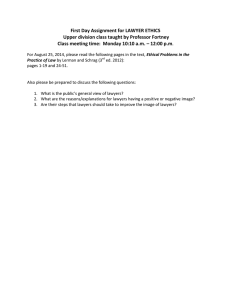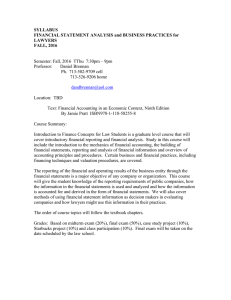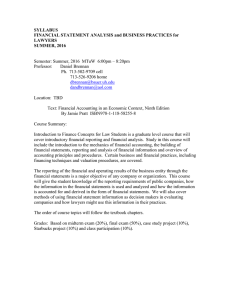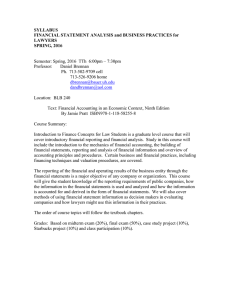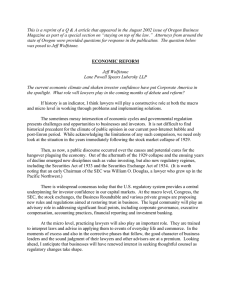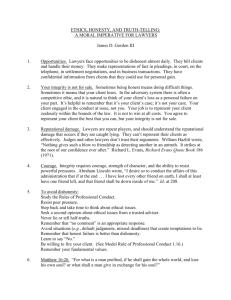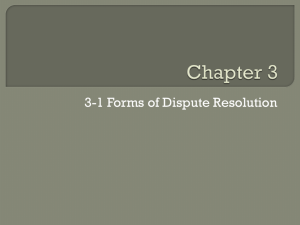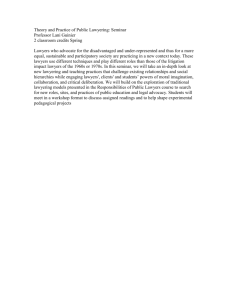Law and Society CJUS/POLS 102 Institutional Roles in the American Legal System
advertisement
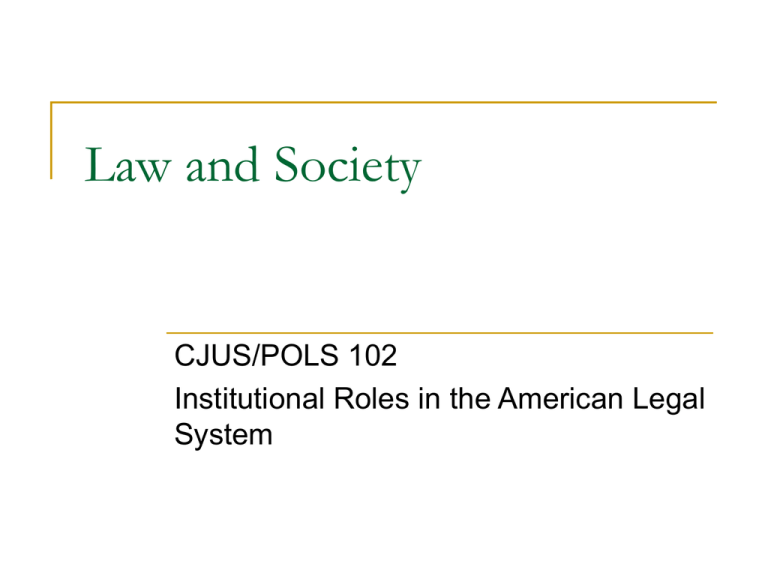
Law and Society CJUS/POLS 102 Institutional Roles in the American Legal System Roles 1. Attorney - depending on circumstances / needs of client - counselor / negotiator / litigator - involved in factual investigations a. Counselor - advise client how to order affairs - whether to proceed with a course of action - how to proceed with pending litigation or settlement Roles b. Negotiator - opposing counsel / favorable resolution - both civil / criminal matters (1) Negotiates with opposing counsel - attempts to get best resolution (2) Client rights - retains right to accept / reject - settlement negotiated / offered by opposing party Roles c. Litigator - pre-trial motions / pick jury - present evidence - witnesses / documents / etc - opening through closing statements (1) Trial attorney - used for criminal matters - used for civil matters (2) Specialize in certain area of law Roles d. Fact investigator - investigation of relevant facts - locating / interviewing witnesses (1) Zealous advocate - advocate on client’s behalf - avoid conflicts of interest (2) Officer of the court - deal fairly / honestly - also with others Roles (3) Ethical rules apply - issues conflict between client and ` court - favor role as advocate of client e. Prosecutor - representative of the court - working for the state -present case against accused Roles (1) Review evidence - from police / defense - make recommendations (2) Interview - police / witnesses - file the case (3) Court process - pre-trial motions - opening through closing statements Roles f. Public defender - representative of the court - working for the state (1) Legal representation - financially disadvantaged (2) Reviews reports - interviews witnesses - directs clients actions (3) Court process Roles - pre-trial motions - opening through closing statements 2. Judge - final arbiter of law (trier of law) - charged with duty to state what the law is a. Trial - passive / referee role - makes evidentiary rulings - inform jury how law is to be applied - maintains order in courtroom Roles (1) When parties agree - “trier of fact” - bench trial (2) Federal judges - appointed by president - “advice and consent” of senate (3) State judges - Washington state - elected / appointed Roles 3. Jury - group of local citizens - fact-finder a. Receive instructions from judge - assess facts - according to law - return verdict 4. Witnesses - professional / lay - have some evidence to present Roles 5. Attorney-Client relationship a. Law touches every aspect of life - cradle to grave - hospitals where born / schools attended - personal / professional relationships - security of funds / medical technology - funeral services b. Law enables us to protect ourselves - by bringing into court Roles - the individual / school district / corporation / or government agency - that injured us / failed to prevent injuries c. Legal system controls all we do - developed by / functions for / controlled by lawyers (1) Most influential throughout history - 25 of 56: signed Declaration - 31 of 55: Constitutional Convention Roles d. Held in distaste - by early colonists (1) After Revolutionary War - needed to legitimize a new America (2) Massachusetts colony (1740) - 1740: 15 lawyers (1 per 10,000) - 1840: 640 lawyers (1 per 1,000) (3) To become a lawyer: Roles - 2 to 3 years as apprentice - ½ hour oral examination e. Development of law schools - late 19th century: private law schools - replaced apprenticeships (1) 1878: American Bar Association - more professional - stringent standards - better educated Roles (2) From “for profit” business = universities - undergraduate degree in law (a) Harvard’s Law Department - entrance exam for 1 yr. program - 1871: from 1 year to 2 years - 1895: 2 years to 3 years - early 1900s: graduate program (b) Law school students: - male / Anglo-Saxon / protestant Roles - difficult for Irish / Italian / Jews - doors shut / bolted to women (c) Women excluded from state bar - until 1870 - 1960: only 3% women lawyers ( 3) 1873: woman challenged Illinois bar - denied access - appealed to US Supreme Court - white / male / protestant Roles - response of court: “The paramount destiny and mission of women are to fill the noble and benign offices of wife and mother. This is the law of the creator.” (a) Slow process - 1923 women admitted (b) Obstacles - Columbia University: 1927 - Harvard: 1950 Roles f. Sandra Day O’Connor - Stanford, 1952 - high grades - difficulty finding work g. Ruth Bader Ginsburg - Columbia, 1959 - tied for first place in class - no offer from major NYC law firm Roles (2) Most dramatic change in legal profession - growth (a) 1960: 286,000 lawyers (b) 1987: 690,000 lawyers (c) 1996: 911,000 lawyers (d) Today: 1.1 million - 1 per 300 population Roles 6. Who can practice law? - must be licensed / member of state bar a. Education - 4-year degree - any major (prefer political science / law and justice / criminal justice / business) (1) LSAT - law school admissions test Roles (2) Law schools look at: - degree / grades / LSAT - school activities - community activities - college attended b. Specialization - first year: general law course work - second / third years: specialize c. State bar exam Roles - pass bar of state - test in several states - most states: after 5 years of practice d. General vs. specialized practice - out of house - small firm (2 – 3 partners) - large corporate firm
